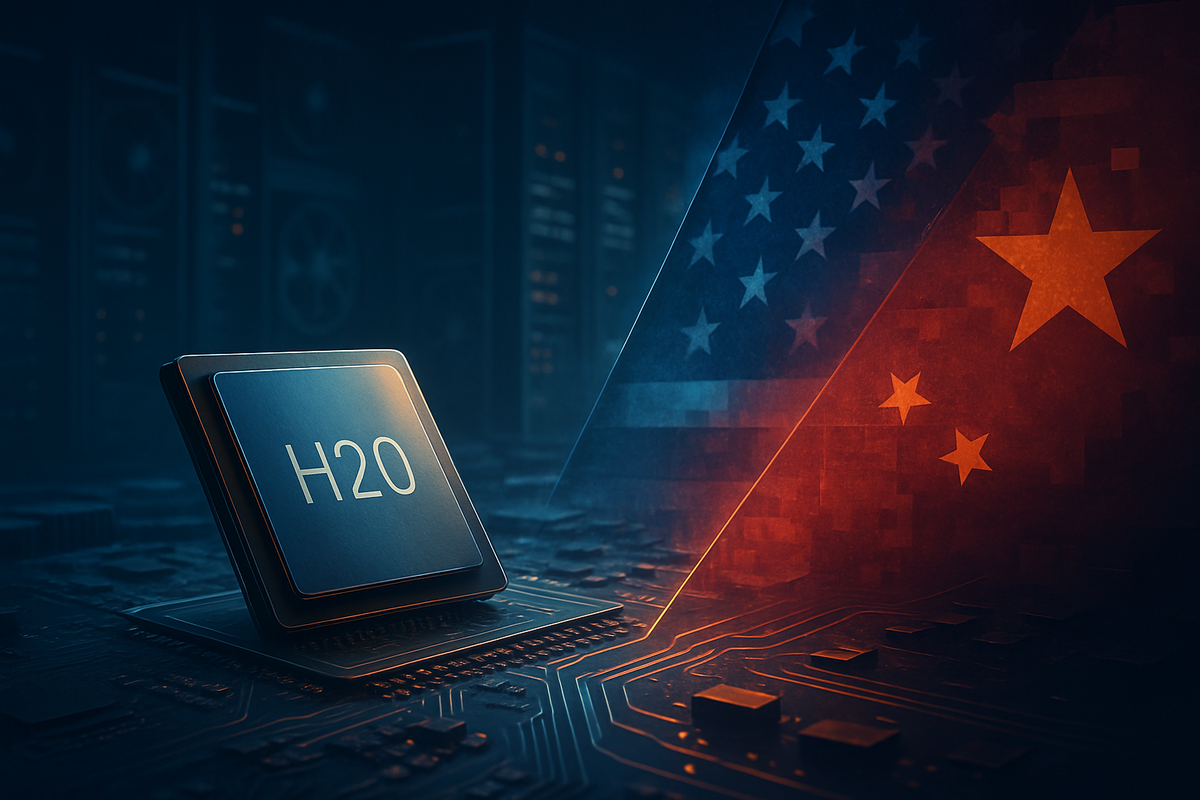NVIDIA Navigates Geopolitical Minefield: The H20 Chip and China's AI Ambitions

The global technology landscape is undergoing a profound reordering, with NVIDIA (NASDAQ: NVDA), the world's leading designer of graphics processing units (GPUs), caught squarely in the crosshairs of escalating U.S.-China technological rivalry. At the heart of this geopolitical challenge is the H20 AI chip, a specialized, "stripped-down" version of NVIDIA's powerful processors, engineered to comply with U.S. export controls aimed at limiting Beijing's access to advanced computing capabilities. While NVIDIA has secured licenses for H20 sales to key Chinese customers, the path to market remains fraught with "geopolitical headwinds" and "regulatory uncertainties," casting a shadow over the company's significant presence in the crucial Chinese market.
This complex interplay between U.S. national security imperatives and NVIDIA's commercial interests has forced the company into an unprecedented balancing act. It is navigating an environment where it must satisfy U.S. restrictions while striving to maintain access to a market that historically accounted for a substantial portion of its data center revenue. The evolving situation not only impacts NVIDIA's immediate revenue streams but also accelerates China's drive for technological self-sufficiency, potentially reshaping the future of the global AI chip industry.
U.S. Export Controls and the H20: A Timeline of Tightening Grip
The story of the H20 chip is a direct consequence of a multi-year effort by the U.S. government to restrict China's access to advanced semiconductor technology. What began as initial warnings to NVIDIA and AMD in September 2022 to halt exports of some top AI chips escalated into comprehensive export controls by the Biden administration in October 2022. These regulations prohibited China from acquiring certain semiconductor chips produced globally using U.S. equipment. In response, NVIDIA initially developed China-compliant chips like the A800 and H800.
However, the regulatory landscape continued to tighten. October 2023 saw an update to the export controls, banning the A800 and H800, leading NVIDIA to introduce the H20. The H20 was specifically designed with reduced memory capacity, making it suitable for AI inference tasks but falling below the performance thresholds for advanced AI model training, thus intended to comply with the new rules. Yet, the regulatory goalposts shifted again. In April 2025, the U.S. government mandated that NVIDIA obtain a license for all H20 AI chip sales to China, effectively pausing shipments and leading NVIDIA to project a significant $5.5 billion revenue impact. NVIDIA CEO Jensen Huang publicly criticized these controls as a "failure," arguing they stifled U.S. economic and technological leadership.
Following intensive lobbying efforts, including direct discussions between CEO Jensen Huang and former President Donald Trump, the Trump administration reportedly reversed the April ban in July 2025. This authorization allowed NVIDIA to resume H20 exports, with the notable condition that NVIDIA agreed to share 15% of its H20 sales revenue from China with the U.S. government – an effective "export tax." Despite this, further delays emerged in August 2025 due to backlogs in the U.S. Department of Commerce's export licensing process. Concurrently, China began advising domestic companies to avoid American chips, including the H20, citing security concerns and promoting local alternatives. This dual pressure has led to reports that NVIDIA subsequently paused H20 production for China. Key players in this saga include U.S. government officials like Commerce Secretary Gina Raimondo and National Security Advisor Jake Sullivan, along with Chinese tech giants such as Alibaba, Baidu, Tencent, and ByteDance, and burgeoning domestic chipmakers like Huawei and Cambricon Technologies.
Winners and Losers in a Fragmented AI Landscape
The U.S. export controls have unequivocally created distinct winners and losers in the global AI chip market, recalibrating competitive dynamics and fostering a rapidly bifurcating technology ecosystem.
The most immediate loser is NVIDIA (NASDAQ: NVDA) itself. Despite its technological prowess, the company has faced substantial revenue losses, with estimates ranging from $5.5 billion to $8 billion in projected sales impact and inventory charges. China was a critical growth engine for NVIDIA's data center business, and the fluctuating regulatory environment has introduced immense uncertainty, reflected in past stock market reactions. While the recent easing of restrictions for H20 sales is a partial win, the 15% revenue-sharing agreement with the U.S. government will erode margins. Moreover, the lingering distrust from Beijing, which advises local companies against using the H20, means NVIDIA's path to fully capitalizing on the Chinese market remains obstructed. Other U.S. chipmakers like Advanced Micro Devices (AMD) and Intel also face similar revenue impacts, compelled to diversify sales and innovate outside the constrained Chinese market. U.S. Electronic Design Automation (EDA) software companies such as Synopsys and Cadence have also experienced lasting revenue damage due as export license requirements disrupt design starts in China. Taiwan Semiconductor Manufacturing Company (TSMC), a critical foundry, is caught in the middle, facing U.S. prohibitions on supplying advanced AI chips (7nm or more advanced) to its Chinese customers, causing operational uncertainties and compliance pressures.
Conversely, the most significant winners are emerging from within China. The restrictions have acted as a powerful, albeit unintended, catalyst for China's technological independence. Beijing has channeled massive state subsidies into domestic chip design and manufacturing, aiming to triple domestic AI chip output. Huawei, despite being on the U.S. blacklist, has shown remarkable resilience, with its Ascend 910B series reportedly rivaling or nearing the performance of NVIDIA's H100 in certain applications. Huawei's robust R&D, focus on compound chip architecture, and its MindSpore software framework are attracting Chinese enterprises seeking homegrown alternatives. Other Chinese chipmakers like Biren Technology and Cambricon have also seen a resurgence, with Biren's BR100 GPU proving competitive with NVIDIA's A100. Chinese tech giants Alibaba and Baidu are also developing and deploying their own AI chips, further reducing their reliance on foreign technology. This surge in domestic capability represents a crucial step in China's drive for technological self-reliance, potentially leading to a substantial shift in global AI chip market share over the long term.
Broader Industry Impact and Geopolitical Ripples
The U.S. export controls on NVIDIA's H20 chip to China are more than just a commercial dispute; they represent a defining moment in the broader trend of technological nationalism and economic statecraft. This marks a "new era of technological nationalism" where critical supply chains are weaponized to achieve geopolitical objectives, leading to the clear emergence of a bifurcated global AI ecosystem. One track aligns with Western technology and standards, while the other is increasingly built upon Chinese-made chips, software, and frameworks.
The most profound, and potentially counterproductive, ripple effect is the acceleration of China's pursuit of technological self-sufficiency in semiconductors and AI. Chinese companies are aggressively integrating self-designed chips and developing end-to-end AI technologies entirely within China. NVIDIA CEO Jensen Huang has acknowledged that Chinese AI competitors, particularly Huawei, have become "formidable" and are rapidly closing the performance gap. This rapid advancement in domestic capabilities could, in the long term, render current U.S. controls less effective and inadvertently harm U.S. companies by limiting their access to a vast market. The prioritization of AI and semiconductors has elevated them to national security concerns, making them central to the competition for future economic and military power. This shift is also fostering a trend toward regional semiconductor ecosystems, moving away from a truly global supply chain model.
Regulatory and policy implications are extensive. The U.S. is demonstrating a long-term commitment to controlling critical technologies, with an evolving regulatory landscape. Proposed legislation, such as the "GAIN AI Act" under a potential Trump administration, could further mandate U.S. chipmakers to prioritize American buyers before exporting processors, potentially shifting from geographical restrictions to capability-based controls. The effectiveness of these controls relies heavily on multilateral cooperation with key allies like the Netherlands and Japan, who have implemented their own related export controls on crucial chipmaking equipment. However, there is ongoing debate about the long-term efficacy of these controls; if major AI advancements take longer, China may achieve semiconductor self-sufficiency, potentially making the controls counterproductive. Historically, these controls echo the U.S.-China trade war and the Cold War-era COCOM regime, where the U.S. sought to limit strategic adversaries' access to sensitive, dual-use technologies. However, the current restrictions are unique in their explicit aim to inhibit the development of China's technological capabilities, rather than merely altering behavior, a more aggressive stance that risks permanent fragmentation of the global tech sector.
What Comes Next: Navigating a Fractured Future
The immediate future for NVIDIA (NASDAQ: NVDA) and the AI chip market remains highly volatile, defined by the ongoing "cat-and-mouse game" between U.S. policy and Chinese technological advancement. In the short term, NVIDIA will likely continue to navigate the complexities of H20 sales. While securing licenses for these chips, the actual sales volume may be constrained by China's quiet push for domestic alternatives and lingering security concerns among its companies. This could lead to an oversupply of H20 chips for NVIDIA if Chinese demand doesn't materialize as anticipated, further impacting revenue and margins. However, NVIDIA's overall global demand for its high-end AI chips (like the H100 and upcoming Blackwell series) outside China remains robust, driven by major cloud providers and emerging AI markets like Saudi Arabia and the UAE, which will continue to bolster its financial performance.
Longer term, the trajectory points towards an entrenched "two-track" global AI ecosystem. China is poised to accelerate its path to technological self-reliance, with ambitious goals to meet 82% of its chip demand domestically by 2027. This means that even if NVIDIA develops new "export-safe" chips with further reduced capabilities, Chinese tech giants may increasingly opt for domestic alternatives that, while perhaps not cutting-edge by global standards, offer security and reliability unhindered by foreign government intervention. NVIDIA's strategic pivots will include continuous innovation in advanced chips for unrestricted markets, leveraging its powerful CUDA software ecosystem as a competitive moat even for compliant chips, and potentially expanding its R&D in China for non-sensitive hardware development. The company will also continue its aggressive lobbying efforts against stricter controls, arguing for balanced policies that protect U.S. interests without stifling global innovation or U.S. company access to critical markets.
Investors should closely monitor several key indicators in the coming months. Foremost are regulatory developments from the U.S. government, as any new restrictions or relaxations will directly impact NVIDIA's access to the Chinese market. The progress of Chinese domestic AI chip developers, particularly Huawei's Ascend series, is crucial, as their ability to deliver competitive performance will dictate demand for NVIDIA's compliant offerings. Investors should also scrutinize NVIDIA's financial reports for the actual impact of H20 sales, absorption of revenue-sharing costs, and successful diversification into other high-growth sectors and regions. Finally, the broader global AI infrastructure spending by hyperscalers will remain a critical driver for NVIDIA's overall growth, offsetting some of the challenges in China. The delicate balance between national security imperatives, economic realities, and rapid technological advancement will continue to define this complex landscape.
Conclusion: A New Era of Tech Geopolitics
The saga of NVIDIA (NASDAQ: NVDA) and U.S. export controls on AI chips for China is a stark illustration of a new era in tech geopolitics, where national security interests are increasingly dictating the flow of critical technologies. The key takeaway is the profound and lasting impact on the global AI chip industry: a permanent shift towards a bifurcated ecosystem where two distinct technological blocs are rapidly emerging. NVIDIA, once enjoying near-unfettered access to the booming Chinese market, has seen its share significantly eroded, reportedly falling from almost 95% to 50% in China's AI chip market since the start of the Biden administration. This has led to substantial financial setbacks, forcing NVIDIA to innovate within a constrained environment while accepting "export taxes" in the form of revenue-sharing agreements to maintain a foothold in China.
Moving forward, the market will be characterized by sustained competition and accelerated innovation on both sides. While NVIDIA will likely maintain its global leadership in high-end AI chips for the foreseeable future, its strategic challenge in China is formidable. The U.S. controls have inadvertently catalyzed China's drive for technological self-sufficiency, fostering formidable domestic competitors like Huawei. This rapid indigenous development, coupled with China's security concerns regarding foreign chips, means that even "compliant" NVIDIA offerings may face an uphill battle for widespread adoption in the long term.
For investors, the coming months will demand acute attention to policy shifts, both in Washington D.C. and Beijing. The actual volume of H20 sales and the performance of NVIDIA's new compliant chips in the Chinese market will be critical metrics. Beyond China, NVIDIA's ability to capitalize on surging global AI infrastructure spending and successfully diversify into other high-growth sectors and regions will underscore its resilience. While the long-term significance points to a more fractured, less integrated global tech landscape, NVIDIA's core innovation and ecosystem strength position it to weather this storm, albeit with a permanently altered strategic outlook. The ultimate impact will be a recalibration of technological power, shaped by both market forces and the long arm of state policy.



